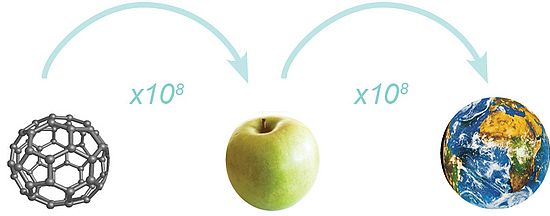What does nano mean?
The term “nano” comes from ancient Greek and means “dwarf” (nános = dwarf). However, the nanosciences deal not with garden gnomes but with tiny nanostructures only a few nanometers in size (<100 nm).
Used as a prefix, “nano” denotes 10-9, just as “kilo” denotes 103 and “milli” 10-3. A nanometer is therefore equal to a billionth of a meter i.e. 0.000000001 m.
A single atom is about 0.1 nm in size. Nanostructures therefore consist of a limited number of atoms and molecules.
To give you an idea of the scale on which the nanosciences operate, here is a thought experiment:

If by magic I could blow up a buckyball molecule with a diameter of exactly 1 nanometer to the size of an apple, by applying the same scale factor, I could blow up an apple to the size of the earth. The size ratio of the molecule to the apple is thus identical to that between the apple and the earth.
It is hard to imagine structures that are only billionths of meters or millionths of millimeters in size. It is even harder sometimes to understand the laws that govern this nanoworld. For nanostructures behave in ways completely different ways to bigger structures. Surface properties of a material become more important than volume properties and quantum mechanical effects increasingly have to be taken into account.
To picture, understand, synthesize and use the very smallest particles, as well as to study the risks they present, we need nanosciences. They are present in many different areas, including materials research, optics, electronics, biotechnology, measurement technology and medicine.
You can find more information in our minibrochure Was ist Nano?
